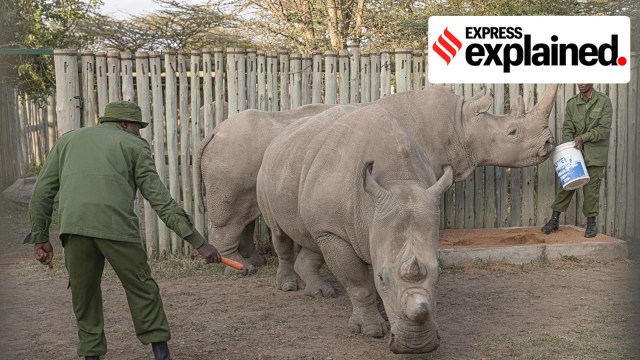The death of the last male in 2018 made the extinction of the northern white rhino an inevitability. But already in 2015, a group of 20 scientists from five continents had launched an audacious and expensive project to rebuild the subspecies through in vitro fertilisation (IVF).
Last week, the scientists announced the first-ever rhino pregnancy achieved by transferring a lab-made rhino embryo into a surrogate mother. It took 13 attempts for the breakthrough with a southern white rhino, a closely-related subspecies that branched away from the northern whites about a million years ago.

The international consortium of scientists, named BioRescue, is confident that the success can be replicated with 30 embryos of the northern white stored in liquid nitrogen. However, rebuilding a species is easier said than done.
Process is the challenge
In 2009, four northern white rhinos were brought from a zoo in the Czech Republic to a conservancy in Kenya in the hope that they might breed in their natural environment. The two males — Suni and Sudan — have died since, and the two females — Najin and her daughter Fatu — turned out to be incapable of reproduction for pathological reasons. This meant surrogacy was the only option to produce a northern white calf through IVF.
Preparing a southern white female, the natural choice for a surrogate mother, is an elaborate process. The first step is to isolate her and put a protocol in place to guard against bacterial infections. The real challenge, though, is to spot when the animal is in oestrus — the fertile window for implanting the embryo.
This requires the services of a ‘teaser’ — a scrubbed and sterilised rhino bull to check when the designated surrogate mother gets interested. Mating also triggers an array of hormonal reactions that primes the female for the embryo implant, Thomas Hildebrandt of Berlin-based Leibniz-Institute of Zoo and Wildlife Research told National Geographic.
Issue of genetic viability
In this case, since the embryos are all from eggs harvested from two females and sperm taken from a few deceased zoo males, even multiple successes with IVF and surrogacy cannot build a gene pool large enough for a viable northern white population.
Story continues below this ad
One solution is to broaden the breeding pool by creating sperm and eggs from stem cells extracted from preserved tissue samples stored in zoos. The science has worked in lab mice, but it may not be easily replicable in rhinos.
Another optimistic argument is based on the natural resilience witnessed in the wild. Rampant hunting had resulted in the southern white rhino population crashing drastically in the 19th century when their numbers had possibly dropped to as low as 20. However, thanks to armed protection and multilateral conservation efforts, the subspecies has made a significant recovery since then, and now number more than 17,000.
But even favourable outcomes from experiments with stem cell techniques cannot stretch the northern white rhino gene pool beyond 12 animals, BioRescue project coordinator Jan Stejskal told The BBC. Crossbreeding the northern and southern subspecies is not a solution since this will result in the loss of certain unique attributes, such as hairier ears and feet, that make the northern white better adapted for swampy habitats.
Being a northern white
Breakthroughs in IVF or stem cell technologies can in theory produce northern white rhino calves long after the species is extinct. However, babies are not born genetically hardwired to behave as one of the species. They pick up those traits from family and social interactions.
Story continues below this ad
So the first batch of IVF northern white calves born to surrogate southern white mothers needs to be raised by northern white adults to learn to be northern whites and carry that legacy for the next batch of IVF calves and, if the species indeed survives, future generations.
That is why scientists consider it absolutely vital that the first IVF calves are born in time to learn the social and behavioural skills of northern whites from the last two surviving females in Kenya. Najin is 35, and Fatu 24. Given that northern white rhinos rarely live beyond 40 in captivity, that window will be closing soon.
Is it worth the money?
The Biorescue consortium, which is led by the Leibniz Institute for Zoo and Wildlife Research (Leibniz-IZW), is funded by the German government and several other public and private donors. Millions of dollars have been spent on the project that aims to make “the seemingly impossible a reality”.
Questions have been asked on whether the project takes focus and resources away from other endangered species that could still be saved. Some critics have also questioned the purpose of rebuilding a northern white population without addressing the threats to its natural habitat, which may jeopardise its future in the wild all over again.
Story continues below this ad
A victim of organised hunting for its horns, the northern white was officially declared extinct in the wild in 2008. In 2015, when Biosecure was launched, only three individuals survived in a Kenyan conservancy. The effort to rebuild the species was inspired by an obligation to try and undo the damage caused by the greed of humans.
One rhino is poached every 16 hours on average in Africa. While the southern whites form the largest surviving rhino species, there are fewer than 7,000 black rhinos in Africa, and only 4,000 one-horned rhinos in Asia.
Populations of the other two rhino species — the Javan and the Sumatran — are down to fewer than 100 each. But there may still be time to help them in the wild before test tubes become their future too.








































